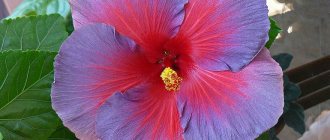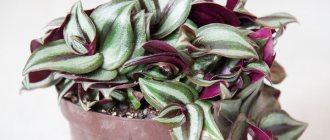Spathiphyllum is a beautiful plant, attractive in its grace and ease of care.
With delicate white blossoms and distinctive emerald green leaves, this graceful flower is a favorite among flora lovers.
True indoor plant lovers and gardeners are always interested in where their favorite flower came from and how it was adapted, as well as its history and those who contributed to making it known to everyone. In this article we will talk about this.
Interesting facts from history
If previously the Araceae family, to which the flower belongs, consisted of only a few varieties, now there are a number of hybrids that differ in stem height , size and color of leaves, size of inflorescences, and abundance of flowering. The varieties of spathiphyllum are discussed in detail in our article.
The name of the flower is easily translated from Greek and means: “spata” - bedspread, “phyllum” - leaf, which quite accurately emphasizes the unusual shape of the inflorescence, reminiscent of a sail.
But spathiphyllums grown for decorative purposes in Russia are often called “female flowers”; people believe in their magical and miraculous properties (what is another name for spathiphyllum and why?).
It is believed that the flower helps to find a loved one, improve family relationships and even get pregnant .
For several years, scientists have been studying the properties of the plant, determining experimentally how it purifies the air we breathe from toxins, dust and other harmful substances. Now we can say with confidence that spathiphyllum is not only beautiful, but also a useful and necessary plant in every home (read about the beneficial and harmful properties of spathiphyllum for humans and animals here).
The flower thoroughly cleanses the air , increasing the oxygen content in the surrounding space.
Graceful spathiphyllum is a very delicate and noble plant. It continues to bloom for almost a whole year, and if you create comfortable and suitable conditions for its maintenance, it will delight its owner with longevity and an abundance of fragrant inflorescences.
If you find an error, please select a piece of text and press Ctrl+Enter.
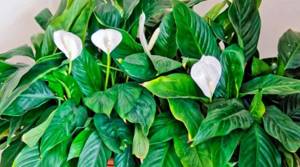
One of the main favorites of many gardeners is the beautiful and delicate spathiphyllum flower. It is distinguished by the elegance of its inflorescences with snow-white petals and emerald-colored leaves. Its origin from distant hot countries did not prevent the flower from adapting perfectly to new conditions, so its cultivation does not cause much trouble for lovers of indoor plants.
Why is the second name of spathiphyllum “Women's happiness”?
“Women's happiness” is the second popular name for the flower. Signs and superstitions are associated with it, and there is also a legend.
Astarte, the goddess of love, was very happy on her own wedding day. This feeling was overwhelming and she breathed some of it into the flower. Since then, the plant has brought happiness, luck and love to all girls who believe in the miraculous power of spathiphyllum.
The opposite of “Women’s happiness” is anthurium, a flower that is called “male happiness”. If you grow them side by side, you can also achieve harmony in your home and relationship with your husband.
Peculiarities
The name spathiphyllum, or in other words spathiphyllum, comes from the Greek words spathe - bedspread and phyllon - leaf. The flower is popularly known as the “white sail” and “women’s happiness.” This is due to the non-standard appearance of the plant; it does not have a stem as such, and the foliage grows directly from the ground in the form of a bunch. The inflorescence, which looks like a spadix, is surrounded by a white blanket.
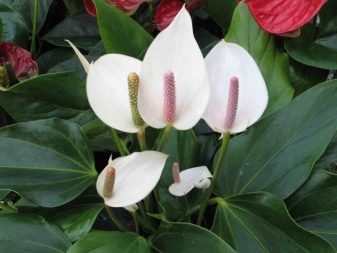
The flowering period occurs in spring and lasts from a week to several months. However, at home you can admire it almost all year round, of course, with proper care. After the bush has flowered, all dead parts must be removed.
Women endow the plant with magical properties. According to legends, it helps to find a soul mate, improve relationships in the family and even have a child.
Scientists have come to the conclusion that “female happiness” is capable of purifying the surrounding air from harmful substances and dust particles and enriching it with oxygen.
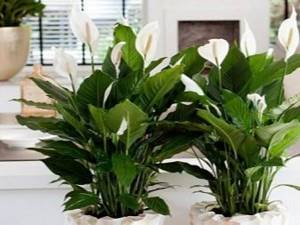
Characteristics of “Women’s Happiness”

The unusualness of the flower lies in the shape of its bushes. Elongated, whole, pointed leaves of a lanceolate, oval shape with thin veins (the central one stands out a little more than the side ones) grow directly from the ground, there is no stem, the petiole is long. The peduncle is located on the root.
The inflorescence is a sessile or pedunculated yellowish spadix with a veil extending from the base. It is shaped like leaves, but exceeds the length of the cob. The color can be different: from white to green.
The green shade of the petal is not as bright as the leaves, and differs from them by a couple of tones. Flowers are bisexual. After the flowering season, the spathe turns green. The seeds are slightly curved and smooth.
History of origin and homeland
The birthplace of “female happiness” is Central and South America. The genus includes more than 40 species, of which 3 came to us from the countries of East Asia and Polynesia.
The distribution area of the taxa covers the Gulf of Mexico, Guiana, Suriname, Guatemala, El Salvador, Panama, Nicaragua, Venezuela, Colombia, Brazil and Peru. The main distinguishing feature of the countries where the bush comes from is the enormous diversity of flora and fauna. The soil in these conditions is represented by a litter of decomposing leaves and branches, which is important to consider when breeding.
You can also meet the “white sail” in the Philippines, Sulawesi and the Solomon Islands. The plant was first discovered in the Colombian and Ecuadorian jungles and described by the German researcher G. Wallis (later one of the species was named after him). Breeders, in pursuit of new varieties, began to import the flower to England, from where it spread throughout Europe, as well as Russia.

Where does it grow in nature?
Spathiphyllum grows in swampy forests, on the banks of rivers and streams, that is, in places where a stable climate with high humidity is maintained throughout the year. In these areas there are no sharp temperature fluctuations (usually 23–29°C), and there are no distinct seasons or seasons. At night the air does not cool down, maintaining a mark of 18°C.
Under natural conditions, spathiphyllum occupies the lower tier of the tropical forest, therefore, despite the abundance of sun, it is content with minor glare. As an adaptation, he grew leaves with larger diameters and lengths to increase the area for photosynthesis and capture of sunlight. Some representatives have adapted to an epiphytic existence, developing on tree trunks.
Conditions for maintaining the house
Despite its exotic origin, this indoor plant does not make any special expensive demands on the gardener. The only and important point in maintaining a flower is to create comfortable microclimatic conditions and maintain them in optimal balance.
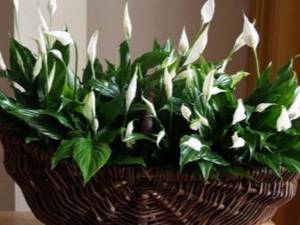
Air temperature
“Women's happiness” refers to heat-loving plants. During spring and summer, the air temperature should be maintained at 22–25°C, with a minimum of 18°C. In the autumn-winter period, the ideal temperature for the life of the bush is 16–17°C. At this time, it is necessary to be especially vigilant, since excessively low temperatures contribute to the development of rot, slower growth and even death of the flower. “Sail” is sensitive to drafts; for example, on a cold windowsill or floor it can fade and fade.
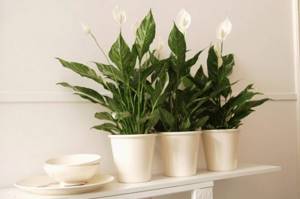
sunlight
Many believe that spathiphyllum is absolutely unpretentious to the amount of sunlight and grows well even in darkened rooms or, conversely, in bright direct rays. However, in practice everything is not so simple. Do not place the pot in direct sun, as ultraviolet radiation damages the shiny foliage, leaving burns. It is also not worth keeping the bush in the crown; due to lack of lighting, the leaves will begin to stretch and acquire a dark green tint.
It is optimal to place the “sail” on the windows under diffused light. In this case, the plant will develop well, and the flowering period may increase slightly.
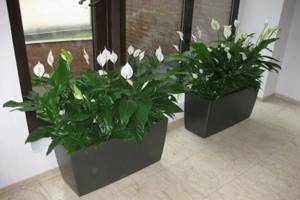
Air humidity
“Women's happiness” arrived in Russia from the tropics and therefore prefers high humidity. At home, the plant must be systematically sprayed (in the warm season, take a shower), add expanded clay or moistened pebbles to the tray, and place a pot on top. But even with this, the tips of the leaves may dry out. During the flowering period, you need to carefully monitor where the water gets; it should not be on the inflorescence and the “bedspread”.
Flowers can be an indicator of a plant’s “satisfaction.” With proper air humidity, they appear in the fall and persist until mid-winter.
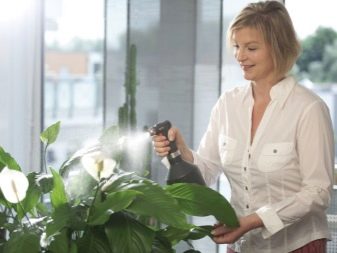
Watering
It is advisable to water the flower only with settled water, with a temperature of about 20°C. In spring, summer and at the time of flowering, it is watered abundantly, guided by the soil (two days after the top layer of the substrate dries). During the dormant period, the volume of watering is reduced, but the soil should never dry out. However, if water stagnates (poor quality soil, excessive watering frequency, or accumulation of liquid in the pan), it must be drained, otherwise the bush may die. The leaves are informative in this regard - if there is a lack of water, the crown droops, and if there is too much, it becomes covered with dark spots.
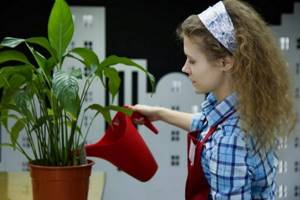
Fertilizer
Spathiphyllum needs year-round application of fertilizers; without them, the beautiful plant blooms poorly, and the flowers are small and inconspicuous. Feeding should be carried out according to the following schedule:
- from mid-spring (when the flower is preparing for flowering and active growth) and until the second half of autumn, fertilizers are applied once every two weeks;
- During periods of rest and sleep, once a month is sufficient.
“Women's Happiness” accepts fertilizers of organic origin well. Mineral fertilizing is diluted to a weakly concentrated solution and after application, or better yet before it, be sure to provide abundant watering.
Lighting selection
Although this crop is considered to be light-loving, prolonged exposure to direct sunlight on young leaves should be avoided. A long absence of light will also not affect the appearance of the crop. But constant shading leads to a change in shape and a decrease in the size of the leaves. In this regard, it is recommended to place the flower in a lighted place in the morning and evening, and in the heat - to put it in the shade.
It is best not to place a pot with a houseplant on the windowsill, as there may not be enough space for it. You can place it directly on the floor or on some table. However, avoid places near radiators in winter, as the heat from them can cause burns on the leaves.
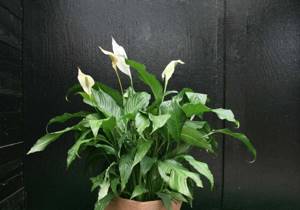
For rapid growth and abundant flowering, diffused light is best. You can use tulle or a piece of agrofibre as a shading material. Remember to increase the percentage of shading as summer approaches. On hot days, this task can be accomplished using a special garden net, which provides up to 50% shading.
Transplantation and propagation
The plant needs to be replanted when its root system no longer fits in the old pot. It is optimal in the spring, when the bush has already left winter, but has not yet begun to prepare for flowering in full force. A flower bought in a store is replanted a month after full adaptation. Before the procedure, prepare a substrate for which you take:
The first three components are in equal parts, the last two are in double volume.

The new house should be 3–4 cm larger than the diameter of the rhizome. The step-by-step replanting process is as follows.
- Spathiphyllum is poured generously with water and set aside for 60 minutes. This is necessary to soften the soil.
- Afterwards, the bush is removed from the old pot and the adhering substrate is carefully cleaned. At this time, the roots are carefully examined and sick and damaged ones are removed; the wounds can be sprinkled with ash.
- The bottom of the pot is covered with small pebbles, crushed stone or pieces of brick. The rest is filled with the prepared substrate.
- Place the bush in a pot, lay the rhizome and sprinkle it with earth.
- Hide the plant in a dark corner for a while.
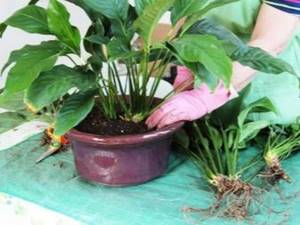
Flower propagation can be done in two ways:
- seed , that is, to germinate from a seed;
- vegetative - division.

Germinating seeds and bringing a small sprout to an adult flower is a painstaking and complex process. Therefore, “women’s happiness” is usually divided. The peeled rhizome is cut with a sharp knife or sharpened scissors. It is important that each root has one growing point and 2-3 leaf blades. The young plant is planted in a pot with a diameter of 15 centimeters, in a specially prepared and moistened substrate. After six months, the new adult “white sail” will begin to delight its owners with its flowering.
What other plant is called “Women’s Happiness”?

Another beautiful indoor plant – zamioculcas or dollar tree, aroid palm – has unusual abilities and pleasant energy.
Grows in a natural environment, suitable for indoor cultivation. The leaves are dense, elliptical in shape, similar to the foliage of the zamia plant.
It is believed that this female patron brings happiness, luck and prosperity to its owner. Found naturally in Africa, it prefers tropical forests.
It exists in a single form - Zamioculcas Zamielifolia. The plants have the same care features; the flowers are annual.
All the girls who believe in the miraculous power of zamioculcas or spathiphyllum and have already acquired them, but have not yet met their destiny, will soon get rid of loneliness forever and start a family.
Origin story
The plant was first described by the German scientist Gustav Wallis, who discovered the flower during a scientific expedition through the tropical forests of Ecuador and Colombia. These countries are considered the birthplace of spathiphyllum, a houseplant. The opening took place at the end of the 19th century. The name of the discoverer is the most popular type of spathiphyllum, which is better adapted to home cultivation than others.
Collectors traveling through the South American jungle gradually managed to find other species of this plant. At first it was bred in the royal gardens of Britain, from where it began to spread throughout Europe and Russia. In the middle of the 20th century, breeders developed new varieties of “female happiness.”
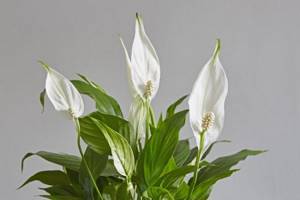
The name spathiphyllum consists of two Greek words that translate as “covering leaf” . In different countries it is called differently: in Europe - “peace lily”, in America - “flag bearer”, and in Russia “women’s happiness” or “white sail” for its resemblance to a piece of ship equipment. According to legends, the flower helps single girls get married quickly, women help maintain love and harmony in the family, and childless families wait for offspring.
Distribution in nature
Despite the fact that the flower comes from the countries of the South American continent, some of its species are found on the islands of Indonesia and Melanesia, in Southeast Asia. It prefers marshy soil near river banks, a humid climate with stable air temperatures.
Its natural habitat is limited to the lower layer of tropical forests. There are species that have adapted to an epiphytic lifestyle on tree trunks. This behavior is explained by a lack of sunlight.
Description of the plant
"Women's happiness" belongs to the araceae family. The main feature of spathiphyllum is its lack of a stem. This structure is explained by living conditions in nature. The lack of light is due to the fact that spathiphyllum grows in the shade of tall thickets. Therefore, the plant has formed large leaves that help it with photosynthesis.

The soil in the tropics is slightly acidic and contains few nutrients . Humus does not contain enough plant residues, as they are washed away by rainfall or absorbed by the roots of large trees. For this reason, spathiphyllum has formed a horizontal rhizome to search for nutrients in the upper part of the soil.
The oval or lanceolate leaves grow directly from the soil . The arrow on which the inflorescence is located grows from there. It resembles an ear of corn surrounded by a white blanket.
This structure is necessary for the flower to attract insects that pollinate the plant.
Varieties and types
Spathiphyllum has about 50 species, the most unpretentious of which are grown on windowsills:
- Domino is a bush 0.5 meters high. The coloring of the leaves is very unusual - the dark green background is painted with white spots, strokes and stripes. In order for the pattern to remain bright, the plant is provided with good lighting. A yellowish flower with a snow-white cover. It has a subtle aroma that appears in the morning and disappears in the afternoon.
- Cupido is a very interesting Dutch hybrid. It is attractive with long curved petals, the pointed tips of which are dark green. Blooms in spring for one month. Feels good on window sills facing east or west.
- The heliconium-leaved species, which is native to the tropical forests of Brazil, has a decorative appearance and unpretentiousness. A bush with large oblong leaves in the shape of an ellipse. They are dark green in color with a glossy surface, wavy edges and a pointed end. The white cob gradually darkens, its size is 10 centimeters. The “sail” surrounding it is twice as long.
- Adorable (pleasant) grows in the African jungle. The color of the leaves is dark green, lanceolate in shape, with an elongated tip. The petioles are long and strong. The blanket is greenish-white, shaped like a small flag. Abundant flowering begins in April and ends in June. Good care ensures flowers reappear.
- Spilt milk (spilled milk) is one of the new varieties. It is interesting for the dim color of the leaves, the green color of which is combined with blurred light green and white shades. Because of this feature it got its name.
- Haiti is a rare variety bred by Dutch breeders. The leaves are soft, leathery, covered with yellow patterns. It is good because it can grow not only in soil, but also in flowerpots with water. As an additional decoration, it is sometimes planted in aquariums.
- The cannoleaf species differs from its relatives in the color of its foliage - it is bright green. To avoid darkening, it is necessary to provide the flower with good lighting. In this case, direct sunlight should be avoided so that the plant does not get burned. Enough diffused light. Blooming spathiphyllum exudes a pleasant scent.
- Picasso stands out for its unusual foliage color. Intense white spots are located not only on the leaves, but also on the spadix and perianth. This variegated coloring makes the hybrid unique among its fellows. Needs abundant watering and diffused lighting.
- Abundantly flowering - native to the tropical thickets of Colombia. It is equipped with many leaves and an underground creeping stem. Lanceolate leaves 25 cm long are located on small 15 cm petioles. The flower stalks consist of a greenish flower surrounded by a concave mantle.
- Japanese is an undemanding specimen. The oval leaves with wavy edges are bright green in color. Pleases with fragrant flowers twice a year. This variety needs slightly acidic soil.
- Sensation is the largest hybrid, up to one and a half meters high. The leaves and inflorescences are also large. The cape with the cob is snow-white, but becomes green over time.
- Wallis is the aroid progenitor of many hybrids. It got its name in honor of the discoverer of spathiphyllum. The characteristics of this species contain common features with other varieties. This is the most common plant pet in apartments and offices.
Give each other love
If, despite all your care, spathiphyllum is not going to produce flower stalks, then pay attention to your family relationships. Perhaps they have cooled down and need to add love to them. According to popular wisdom, “female happiness” does not bloom if quarrels and scandals constantly occur in the house. For a plant to delight with lush flowering, mutual love must reign in the house.
And most importantly, if “female happiness” also brought human happiness into your home with a houseplant, do not forget to share it with others by simply giving the plant to your family and friends, then the gifted happiness will definitely return to you a hundredfold.
Content Rules
Caring for a plant does not require special knowledge and skills. Spathiphyllum is unpretentious to environmental conditions and easily tolerates temporary inconveniences. However, for abundant flowering and good growth, the following rules must be observed:
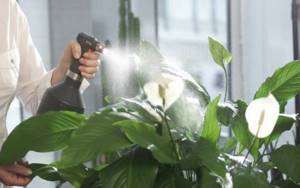
- Diffused light or partial shade;
- absence of drafts;
- temperature regime;
- periodic spraying;
- timely watering.
In places where the sun's rays penetrate, you should avoid contact with your pet's leaves to avoid burns. At the same time, it is necessary to provide the “white sail” with enough light, since with insufficient lighting its leaves become small and inexpressive.
It prefers room temperature, approximately 22 degrees Celsius, but it also grows at lower temperatures. In cold rooms where the air does not warm up above 16 degrees, it can stop growing and get sick.

A prerequisite for health and flowering is to increase the humidity of the surrounding space. In the spring-summer period, the plant is sprayed 2 times a day. A good solution would be a container with a small layer of expanded clay or pebbles in which a flower pot is placed.
The amount of watering depends on the time of year and the stage of development of the “white sail”. During flowering and intensive growth, the amount of water is increased. In the autumn-winter period, watering is done infrequently and moderately. The water temperature must be at least 18 degrees. It is necessary to monitor excess moisture in the pot and avoid stagnation.
Despite good immunity, spathiphyllum can be attacked by the following pests:
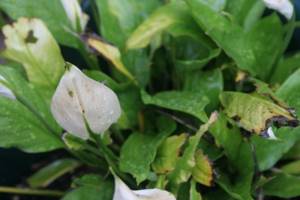
If you don't fight them, the flower will die. If insects are detected, it is necessary to treat the plant with insecticidal preparations, and a warm shower is suitable for water procedures. When attacked by pests, spathiphyllum leaves become covered with dark spots, turn black and die.
Of the diseases that can destroy the “white sail,” late blight and root rot pose the greatest danger. To prevent these pathologies, you need to monitor soil moisture, avoiding its excess. Treatment with Fitosporin M, Alirin B, and Planriz is mandatory.
Lack of flowering may be due to lack of fertilizer or moisture. It is also important to remember the age of the plant: it blooms after reaching maturity.
Reproduction and transplantation
Reproduction occurs in three ways: apical cuttings, seeds and dividing the bush. The first two methods are impractical, since “female happiness” produces enough offspring. When it appears, the bush is divided into parts so that sprouts and roots remain on each of them.
The planting container should not be too spacious . Excess space in the pot promotes intensive root development, which leads to poor flowering until it stops completely.
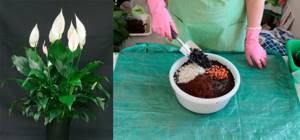
Humus, peat, leaf soil and turf are placed in the soil . A mixture of hydrogel granules, crushed sphagnum and sand is added as additional components. There should be 2 times more turf in the soil than other elements.
During transplantation, care should be taken not to damage the rhizome. For mandatory drainage, brick chips and charcoal in small quantities are suitable.
Fertilizer feeding is carried out 2 times a month in the warm season, as well as during the growth and flowering period. With the onset of winter, this procedure is limited to one time. Bird droppings and preparations for indoor flowers are well suited as organic matter.
Useful qualities
Spathiphyllum is a phytoncidoactive plant. It purifies the air from carbon monoxide, formaldehyde, acetone and other substances harmful to health. Large foliage releases enough ozone to make it easier to breathe indoors. In addition, “female happiness” improves attention and performance, which is why they often decorate offices and rooms for school-age children.
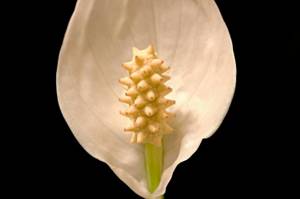
“White Sail” is often used to decorate living corners in kindergartens. In this case, a plant passport is drawn up, which presents illustrations and a brief description of the evergreen pet.
When placing a flower in an apartment, it is important to remember that its juice is poisonous. Getting on the mucous membrane, it causes salivation, burning and pain in the stomach. Therefore, it is necessary to ensure that it is not accidentally consumed by pets and small children.
Recommendations for purchasing
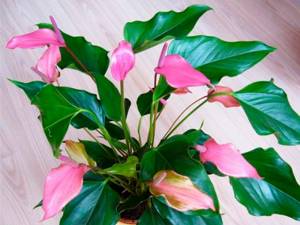
On the shop windows, all the flowers look well-groomed and healthy. However, before acquiring “female happiness”, it is important to adhere to several recommendations. Inflorescences and shoots, leaves and soil require close attention.
There should be no damage, yellow or dark spots, or other defects on the sheet plates. A healthy plant has dense, juicy and glossy foliage. Perianths, inflorescences and petioles without signs of drying out. The presence of mold, unpleasant odor, excess water, and cobwebs is unacceptable in the soil. Careful inspection will help you grow a beautiful and useful plant.
Pests and diseases
Spathiphyllum can be attacked by spider mites. Its appearance will be indicated by a small cobweb between the leaves. In this case, you should treat the plant with a special agent to prevent the death of your “female happiness”.
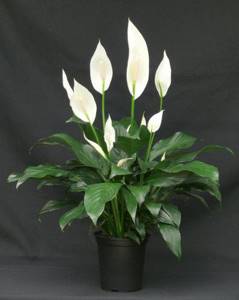
Also, the plant may begin to dry out due to improper care. Wilting leaves indicate a lack of moisture. The appearance of yellow edges on the leaves indicates an increased concentration of chlorine in the water. If the color of the plant has become dull, then it does not get enough sunlight.
